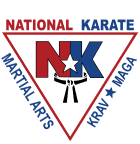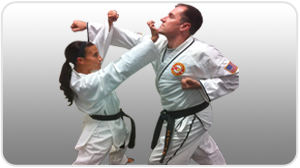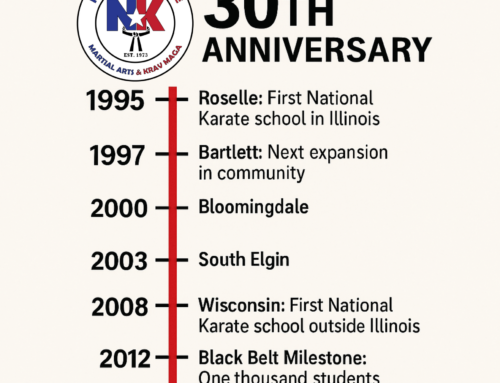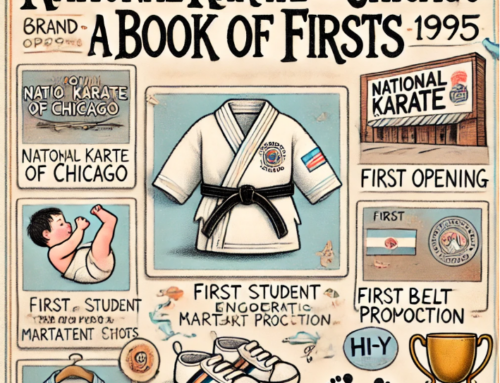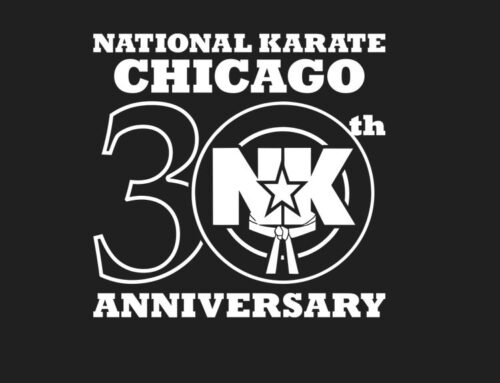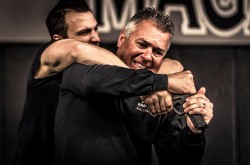
Origins of Krav Maga
Krav Maga Classes have a deep Israeli connection and in fact is the current self-defense system taught to the soldiers in the Israeli Defense Forces (IDF) which is considered one of the best trained militaries in the world. According to Cultural Anthropologist Jurgen Schaflechner Martial Arts Studies, the word Krav Maga is Hebrew for close combat or touch fighting. Its precepts include a “no rules” form of self-defense. Krav Maga is taught anywhere and everywhere, from gyms to martial arts schools, as a self-defense training practice for a multitude of dangerous environments. Often, Krav Maga is presented as a skill that can assist in life-threatening circumstances.
The system was created by Emrich Imi Lichtenfeld who was a Jewish wrestler and boxer in the Israeli Defense Force (IDF). Civilians began practicing it in 1964, and it became known worldwide mainly for “dirty fighting” from holds, relentless gut punches, and eye gauges. The American film Enough demonstrated this ceaseless attacking characteristic of Krav Maga’s self-defense. As Slim (Jennifer Lopez) trains under her instructor, who asks her what she does after she finishes attacking. She replies, “Nothing because I never stop attacking.” Slim ultimately kills her abusive husband in self-defense by the film’s end, using Krav Maga.
Krav Maga vs. Karate from this angle alone shows a primary difference–it is no respecter of persons, pointing us to even deeper roots. During the multiple Jewish settlements in Palestine, the paramilitary organization eventually developed the Hagana (the defense) and kapap or Krav panim el panim, meaning face-to-face combat. Kapap fused jiu-jitsu, boxing, and wrestling. Once Lichtenfeld moved to Palestine, he began training Jewish settlers in hand-to-hand combat, not limited to knife fighting and knife defense. Once Israel became a state in 1948, Hagana and IDF became one unit and adopted both kapap and Krav Maga (Martial Arts Studies).
In Krav Maga classes, you’ll also learn weapons defense (like knife, gun or club defense), some ground defense, hand to hand combat, striking, punches, kicks and holds. Your training will incorporate very real-life situations. Krav Maga relies on instinct and intuition. Primary principles of this fighting style include neutralizing the threat, simple motions, defensive attack, non-stop motion, use of weapons of convenience, and focus on pressure points. The longer you train, the better you will learn to defend yourself instinctively and effectively.
Krav Maga was found effective even after a single training session, according to a 2019 Krav Maga study for women. After learning the basics, participants were able to remember Krav Maga’s strikes in an almost automatic manner. Further, they found that learning how to execute a proper kick could lead to continuously increased velocity and force of impact. Krav Maga involves rapid training within a session and can boost your confidence immediately.
Your instructors will train you for endurance and stamina in an effort to sustain defense while help is on its way. You’ll also learn what to look for when a situation escalates to the point of physical aggression and how to de-escalate it. A primary focal point of the training is situational awareness. Krav Maga vs. Karate is an adaptive self-defense system, while Karate pulls from spiritual tenets relying heavily on peace and deep focus. But Karate’s true origins may surprise you.
Origins of Karate
Karate is Japanese for “empty hand.” Broken down, ‘kara’ means empty, and ‘te’ means hand. It focuses on the holistic betterment of the whole person while incorporating the martial arts discipline of kicking, striking, and blocking. Power and impact are focal points, requiring deep concentration to employ the most effective maneuvers. Karate uses a combination of points of impact from the foot, heel, forearm, knee, and elbow to strike an opponent’s targets. Primary tenets in Karate are as important as technique and mental toughness.
Krav Maga vs. Karate seeks to make contact to the point of hurting one’s enemy. In Karate, students will have a sparring partner and will practice controlled contact that allows them to practice fighting without damaging one another. However, if a Karate student had to use their skills in a self-defense situation they could turn off the control and hit their attacker with full impact. Some of Karate’s principles are respect, honor, indomitable spirit, focus, humility, integrity, perseverance, and self-control. Karate for kids is especially regarded because it is more than a sport or activity and is not focused on aggression but on mentality and whole person development.
According to the Smithsonian, even though Karate has always been associated with Japan, Japan only very recently considered it a martial art 86 years ago. Additionally, Karate originates in Okinawa, an independent kingdom that’s actually steeped in Chinese influences, not Japanese. Beyond its origins, the belt system that Karate is known for was not used in ancient times. The colored belts and uniforms only became popularized in the 1920s as a way to help students see their progress in learning the ancient art. At a time when emperors would confiscate weapons from its people in order to maintain control Karate became a way for people to fight without weapons. (Hence the name Karate which means “empty hand”.) It is believed that Karate’s discreet invisibility protected its history and discipline from all but being wiped out. Because many people did not know what Karate was, and it had not garnered the level of visibility it has today, it was able to fly under the radar and avoid suppression after WWII.
Karate’s Okinawan roots began in the 1300s within the Ryukyu Kingdom, signified by a rich tradition of language, dress, cuisine, and ceremonies despite a samurai invasion from the mainland. Karate then became an underground rebellion. They were prohibited from carrying swords in public. This secret unarmed combat was born out of resistance and utilized fusions of martial arts from China, with scythes, staffs, and the recognized nunchucks as weapons of choice. People initially used nunchucks for farming. Karate was guerilla warfare shrouded in secrecy and protection. Its original origins lacked uniforms, belts, ranks, and styles. At its epicenter was self-discipline, restraint, and peace with a “no strike first” rule. Karate could be lethal when self-restraint is not exercised. Its core components are diplomacy over aggression (Smithsonian).
How Krav Maga and Karate Differ
At the outset, we may assume that these practices are the same but differ significantly in their real-world uses. While they are both excellent for self-defense, Krav Maga has eliminated any elements that do not have direct self-defense efficacy. While part of the beauty of Karate is that it is an ancient art with traditions. Krav Maga also incorporates martial arts but is not itself a martial art. On the other hand, Karate masters learn many techniques, disciplines, and styles customary for their area of expertise and their given schools. For instance, National Karate teaches a combination of martial arts, which include Tae Kwon Do, Karate, Kickboxing, and Krav Maga. One other difference is that while both Krav Maga and Karate use powerful kicks, the Karate practitioner typically has a much higher proficiency in kicking ability.
Krav Maga is a hit first, ask questions later system, while Karate is a never hit first practice. Karate encourages you not to fight unless you are attacked first.
Krav Maga focuses on soft spots such as the eyes, nose, ears, jaw, throat, groin, and knees. These areas will always be vulnerable and soft, which makes this defense system adequate no matter how small you are compared to a predator. Your goal is simple–subdue and flee. It’s crucial to train heartily in Krav Maga because of its benefits for stamina and fitness. You never know in real-world situations how long an attack may last. Karate also focuses on hitting vulnerable targets but it also has a “sport” component to it that students can compete in. When doing competitions Karate focuses on point systems that measure balance, accuracy, and speed. In competition, this is called Kumite or sparring. Safety and discipline come first, and opponents are scored based on the skill of their punches, kicks, and takedowns. Judges evaluate the form and technique of every action. Competitors are not allowed to make excessive contact with their opponent or act disrespectfully toward any party on the mat, including the referee. Doing so can cause one to be disqualified or receive a penalty. National Karate is host to North America’s largest sport karate tournament called the Diamond Nationals. It gets its name from the fact that the Black Belt winners receive diamond rings as a prize!
Krav Maga Classes:
- No rules in self-defense; “dirty fighting” encouraged
- Not a martial art; combat-focused
- Used in life or death situations
- Weapons defense
- Does not require a uniform
- Very practical
- Recommend for kids and adults ages 15 and up
- Operates from a six-pillar system
- Aggressive and tactical
Karate Classes:
- Operates on obvious tenets of self-discipline, honor, and respect.
- There are rules to the use of Karate when in competitions that use a point system
- There are belts to earn and competitions to win
- Requires a uniform
- Karate for kids ages 4+ and adults of all ages
- Incorporates philosophy and holistic training methodology
- Offers developmental advantages such as memory, social skills, concentration, confidence, self-esteem, and achievement
- High proficiency in kicking
How Krav Maga and Karate Are Similar
Though there are pronounced differences, these disciplines have more in common than you might think. Krav Maga and Karate are both “striking styles” that are known for explosive power when striking their opponents. Krav Maga Classes and Karate Classes require discipline, focus, and the development of situational awareness. Both Krav Maga and Karate teach you to anticipate your opponent, how to remain calm, and use your fear to your advantage when being attacked.
A prime example of using your fear can be seen in the film Enough when Slim imagines her husband immobilizing her and getting the upper hand. Her instructor taught her to use the fear that he would overpower her so she could anticipate his next move. He would try to overpower her and kick her while she was down. His kicking her would be her way to subdue him as he would assume she would be incapable of defending herself against his strength and size.
In The Karate Kid starring Jaden Smith (Dre), he and his mother move to Beijing, China, from Detroit. Not only does he undergo profound culture shock and homesickness, but he gets viciously bullied the same day he arrives. This bullying set the tone for his new life in China, which was marred by low-self esteem, a lack of confidence, and fear. Though Dre didn’t take that first fight lying down, he didn’t have the technique or confidence of his opponents. Though this movie features Kung Fu stylings, the basic tenets of respect, honor, discipline, and effort were the same. Dre underwent a total transformation once he began his training under Mr. Han. Karate classes offer a similar level of transformation visible in this film. The reality is that bullying is common, and children are often at the mercy of others when they don’t have the skills Karate teaches.
Though aggression is not an emphasis, children will learn how to stand up for themselves in the face of bullies and prevent others from falling victim to the same. The film touts Karate for the confidence it instills. By the movie’s end, Dre is competing against the same kids who jumped him on his first day in Beijing. He is more focused, stronger, bolder, and more fit physically and psychologically. Although injured, he built up his mental toughness so much that he competed to overcome his fear and win. He clung to the perseverance he had learned throughout training to say the tournament through until the end.
Children as young as 15 and adults can learn both Krav Maga and Karate. Both offer fitness elements and can be an excellent full body workout. Whether you’re seeking to arm yourself with helpful self-defense techniques with Krav Maga or teach your child the pillars of self-discipline through Karate, there is something in it for the entire family.
Similarities of both Krav Maga and Karate:
- Eastern roots
- Striking arts
- Forms of discreet defense and protection
- Concentration central tenents
- Situational awareness development
- Effort required
- Fitness elements
- Bully prevention
- Learned by children and adults
Ready to get started with Krav Maga self-defense and or Karate classes? When you try our 3-week trial and purchase Karate for kids classes, a uniform comes free! Try out Krav Maga self-defense classes with a 2-week free trial. Please give us a call or get signed up here; we have four locations in the western suburbs of Chicago, Illinois. We can’t wait to see you and help you get started.
